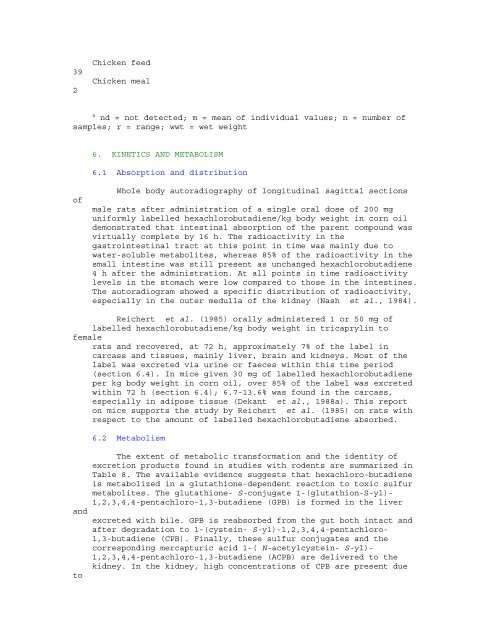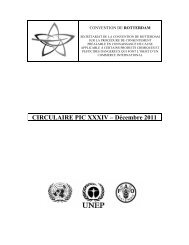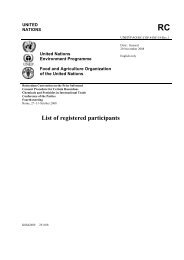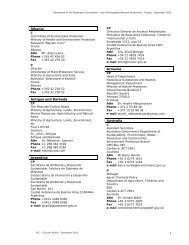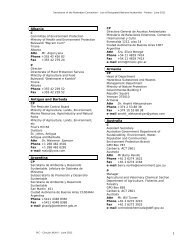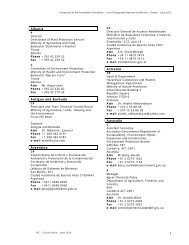RC - What is RC? - Rotterdam Convention
RC - What is RC? - Rotterdam Convention
RC - What is RC? - Rotterdam Convention
Create successful ePaper yourself
Turn your PDF publications into a flip-book with our unique Google optimized e-Paper software.
39<br />
2<br />
Chicken feed<br />
Chicken meal<br />
a nd = not detected; m = mean of individual values; n = number of<br />
samples; r = range; wwt = wet weight<br />
of<br />
6. KINETICS AND METABOLISM<br />
6.1 Absorption and d<strong>is</strong>tribution<br />
Whole body autoradiography of longitudinal sagittal sections<br />
male rats after admin<strong>is</strong>tration of a single oral dose of 200 mg<br />
uniformly labelled hexachlorobutadiene/kg body weight in corn oil<br />
demonstrated that intestinal absorption of the parent compound was<br />
virtually complete by 16 h. The radioactivity in the<br />
gastrointestinal tract at th<strong>is</strong> point in time was mainly due to<br />
water-soluble metabolites, whereas 85% of the radioactivity in the<br />
small intestine was still present as unchanged hexachlorobutadiene<br />
4 h after the admin<strong>is</strong>tration. At all points in time radioactivity<br />
levels in the stomach were low compared to those in the intestines.<br />
The autoradiogram showed a specific d<strong>is</strong>tribution of radioactivity,<br />
especially in the outer medulla of the kidney (Nash et al., 1984).<br />
Reichert et al. (1985) orally admin<strong>is</strong>tered 1 or 50 mg of<br />
labelled hexachlorobutadiene/kg body weight in tricaprylin to<br />
female<br />
rats and recovered, at 72 h, approximately 7% of the label in<br />
carcass and t<strong>is</strong>sues, mainly liver, brain and kidneys. Most of the<br />
label was excreted via urine or faeces within th<strong>is</strong> time period<br />
(section 6.4). In mice given 30 mg of labelled hexachlorobutadiene<br />
per kg body weight in corn oil, over 85% of the label was excreted<br />
within 72 h (section 6.4); 6.7-13.6% was found in the carcass,<br />
especially in adipose t<strong>is</strong>sue (Dekant et al., 1988a). Th<strong>is</strong> report<br />
on mice supports the study by Reichert et al. (1985) on rats with<br />
respect to the amount of labelled hexachlorobutadiene absorbed.<br />
and<br />
to<br />
6.2 Metabol<strong>is</strong>m<br />
The extent of metabolic transformation and the identity of<br />
excretion products found in studies with rodents are summarized in<br />
Table 8. The available evidence suggests that hexachloro-butadiene<br />
<strong>is</strong> metabolized in a glutathione-dependent reaction to toxic sulfur<br />
metabolites. The glutathione- S-conjugate 1-(glutathion-S-yl)-<br />
1,2,3,4,4-pentachloro-1,3-butadiene (GPB) <strong>is</strong> formed in the liver<br />
excreted with bile. GPB <strong>is</strong> reabsorbed from the gut both intact and<br />
after degradation to 1-(cystein- S-yl)-1,2,3,4,4-pentachloro-<br />
1,3-butadiene (CPB). Finally, these sulfur conjugates and the<br />
corresponding mercapturic acid 1-( N-acetylcystein- S-yl)-<br />
1,2,3,4,4-pentachloro-1,3-butadiene (ACPB) are delivered to the<br />
kidney. In the kidney, high concentrations of CPB are present due


